Having a horse that loads easily into a trailer while keeping nice and calm is essential if you ever plan on taking your horse anywhere. In this post I’m going to talk about how to train a horse to load in a trailer. I hope it’ll help you – whether you’re new to horse loading or even if you’ve already been doing it for a while but you’ve got a stubborn pony on your hands.
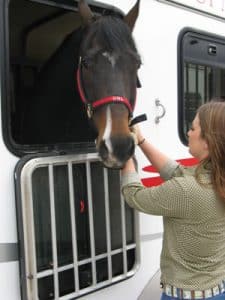
Even if you’ve got a super cooperative horse most of the time, there might be that one spot or situation that just sets him off.
RELATED:
Imagine this…
Let’s say you’ve taken your horse for a trail ride with the trailer. And then suddenly half way through the ride it starts to rain. By the time you make it back to the trailer, you’re wet, the horse is wet and you both just want to go home and get dry.
But in the meantime it has also started to thunder and your horse is a little uneasy. For the first time ever, he just refuses to load. It’s times like these where it is so important to have a plan and remain patient.
I know it can be super frustrating trying to load your horse into the trailer when they just don’t want to go. Whether this is your first time loading your horse or your hundredth, the first step is to take a few slow, deep breaths. Just remember that you will get past this!
Now that you’re reading this, you will have a solid plan and mindset in place when such a situation does happen. I hope you’ll also do some test runs with your horse to prevent it from happening in the first place. So you can just lean back, relax, grab a coffee or tea and read this post. You’ll be good to go when it comes to trailer loading.
Yes, horses can be stubborn, but they usually have good reason
First of all horses are in their very nature flight animals. Try and put yourself in your horse’s shoes. He might have a really good reason for not wanting to be in that trailer.
Horses instinctually run away from danger, which is why they’re so fast. So you’re asking your horse to give up access to one of his key instincts. You better earn all of your horse’s trust if you want him to do that regularly, especially in challenging situations.
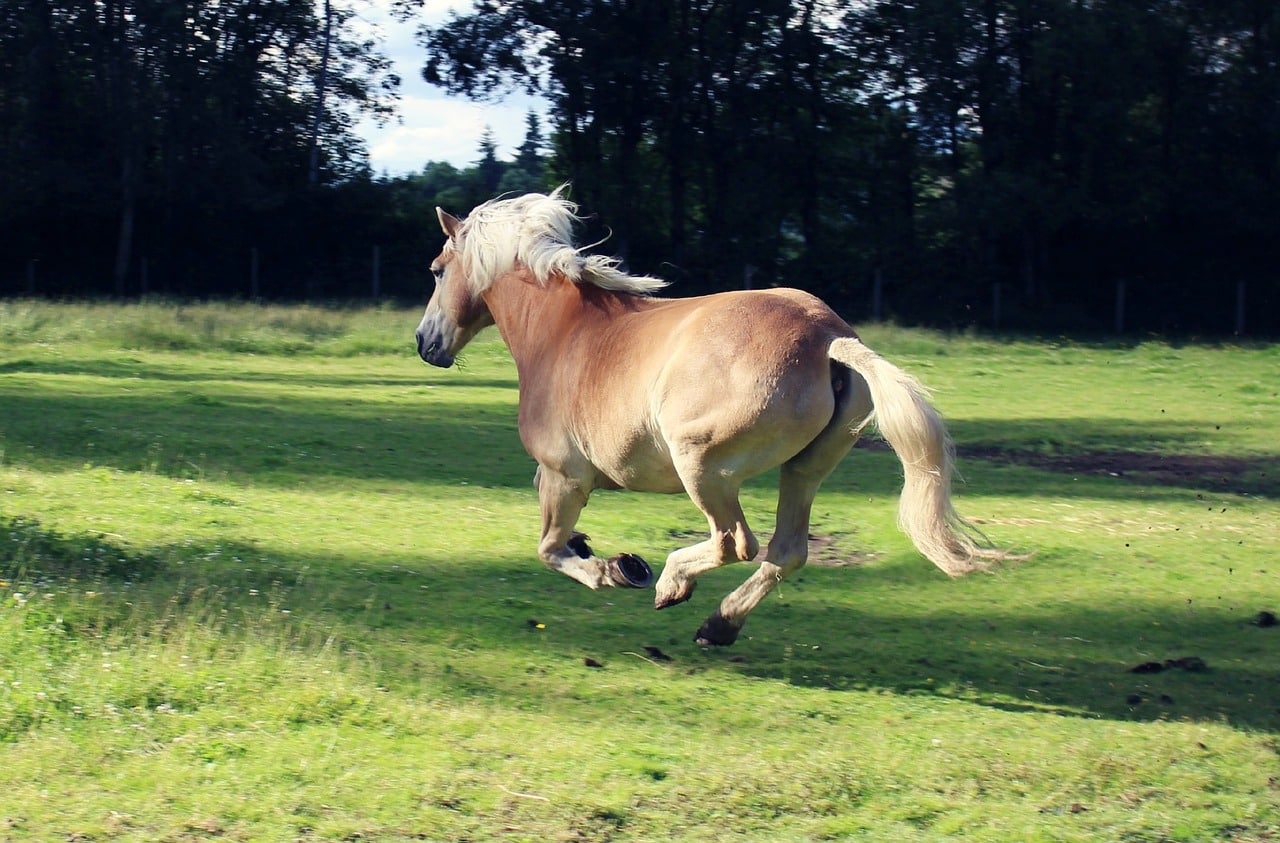
Secondly, the inside of a horse trailer looks unpleasant to your horse. He’s probably never been somewhere quite that enclosed and dark before. I mean how would you feel if someone tried to stuff you into the equivalent? Especially if they weren’t able to actually explain to you why they were doing so.
Thirdly, if your trailer is not very sturdily built, your horse might be able to feel the give beneath him and think it’s unsafe. Make sure there is no give in the ramp or the floor of the trailer and this won’t be an issue.
Finally, if your horse is already a little nervous about getting in and you start to get annoyed and anxious – then what do you think is going to happen to him? He’s going to be like, oh my gawwwdddd I was right, something’s wrong. And then he’s going to try his very best to run away from the situation.
So keep calm and take it slow so that your flight risk stays put.
Horse trailer loading 101
Now that we’ve talked about staying calm, let’s get into the process. I’ve broken it down into the following 6 steps. They are exactly what you’ll need in order to train your horse to load into a trailer no matter the circumstances. Now during these steps, just remember to keep in mind why your horse is hesitant. Use that to keep your patience no matter what.
Step 1 – The forward & backward cues
First and foremost comes the part without the trailer. That’s right, for this your horse shouldn’t even be near the trailer. Your horse shouldn’t even be able to see it because this might trigger nervousness.
You and your horse should both be calm and relaxed and there should be treats involved. All you’re going to be doing is some simple ground work in order to teach your horse to walk backwards and forwards based on your cues.
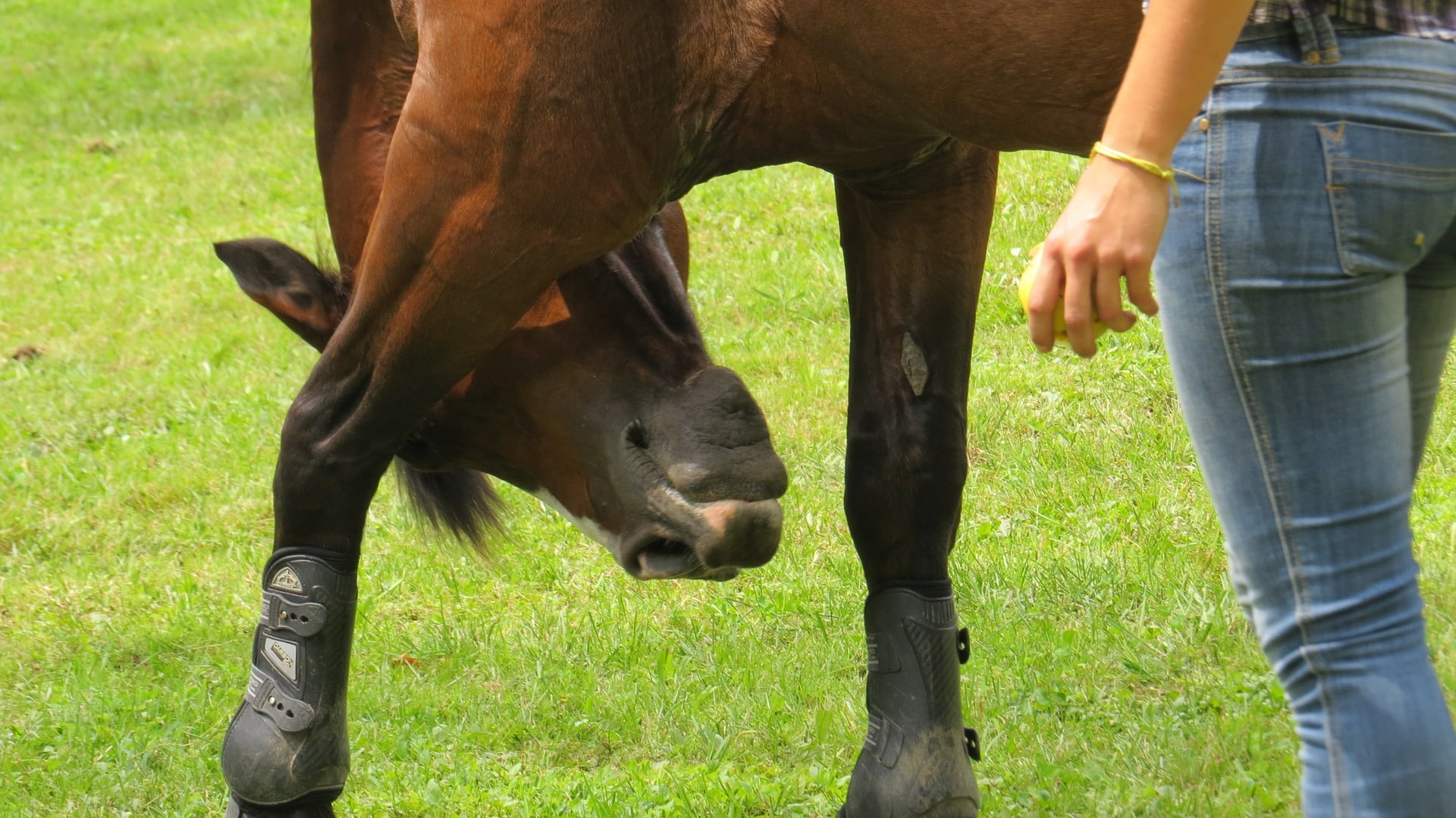
This type of training will come in handy in many cases, not just trailer loading. So it’s definitely something that’s important to do if you haven’t already done it.
Going forwards…
The going forwards cue is going to be some kind of verbal cue while applying pressure to the hip with a crop. You can use whatever verbal cue you want. It can be a sound like a kissing sound or a clicking sound or it can be a word such as “forward” or “walk”.
Get into position such that you’re standing near your horse’s head. Establish for yourself a direction that you’re going to call ‘forward’. Use a halter and a lead rope so that you can interact with your horse’s head. During the exercise keep your horse’s head pointed in the ‘forward’ direction and use the crop to keep their body aligned.
Horses are very good at evading. So your horse may try to evade going in the direction you are suggesting by moving side to side and shimmying their hips. You have to make evasion unpleasant for them by using the crop.
So while keeping your horse’s head pointed forwards, give your verbal command and start tapping gently at your horse’s hip with the crop. If your horse moves forward in the direction that their head is pointed, then immediately stop the tapping with the crop and give rewards. So pet his or her neck and give praise in a happy, rewarding tone.
If your horse moves backwards, then increase the pressure of the tapping with the crop. If your horse starts evasive manoeuvers then keep walking around with him or her until he’s all straightened out again, using the crop when appropriate – such as when his bum is moving towards you.
Keep working at this until your horse moves forward immediately at the sound of your verbal cue only. Give plenty of praise for every step in the right direction (pun intended)!
Going backwards…
This time you’re going to need two people. One person handling the horse’s head and one person near the horse’s rump to give the cue. The cue is again some type of verbal command followed by a pull on a clump of strands from the horse’s tail.
Of course, don’t yank on the tail like it’s your job but don’t treat your horse like a porcelain doll either. Just a quick little tug so that your horse can actually feel it.
Use the same principles that you used to make your horse move forwards, except now with the goal of moving backwards. This time use the crop on the horse’s shoulder as opposed to their hip.
As always, give plenty of praise for every step in the right direction!
For both of these exercises, keep in mind that you do not want to reinforce bad behaviour. This means you have to be more stubborn than your horse is. Don’t let your horse go in the wrong direction for even a few steps to “let him get it out of his system” kind of thing.
Your horse sees this as reinforcement and it will confuse him about what you’re trying to do. You have to be a great leader with a very single-minded view and your horse will follow. If you’re worried about being too demanding, here are some of my tips!
Step 2 – Introduction to the trailer
Now we’re getting to the trailer part (yay)! In this step you also want to have some treats with you. And you might want to start off a bit of a distance away from the trailer.
Give your horse verbal praise and a treat for just looking at the trailer. Right away you want your horse to associate whatever that thing is over there with good stuff. This will put your horse in a positive mindset about going to check it out.
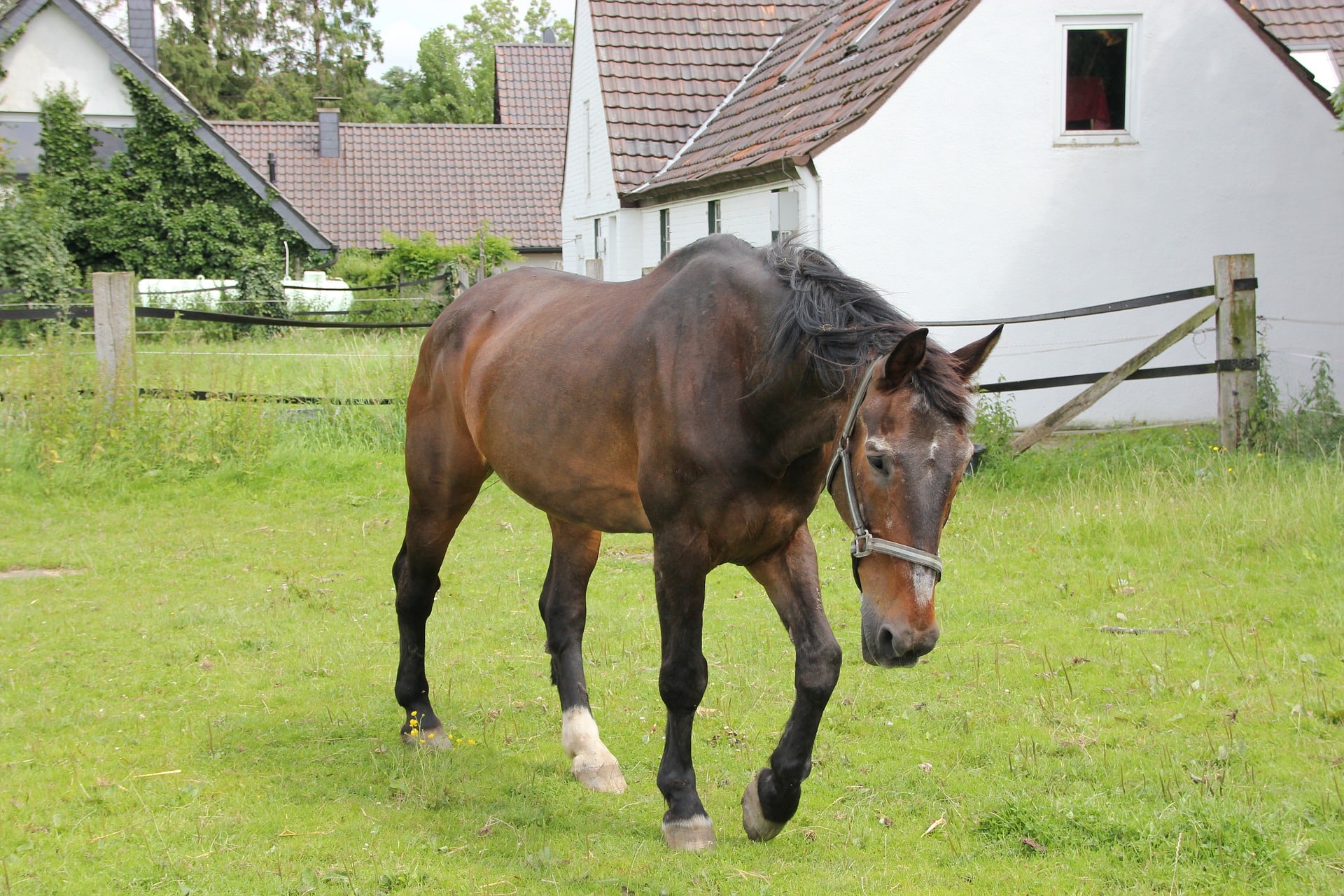
Next, you’re actually going to walk your horse over to the trailer so that your horse can sniff at it and generally give it a look over. If your horse approaches the trailer with a low head and pricked ears, reward that too – it means your horse is relaxed and ready to learn more about this thing.
For this step, have your trailer open so that if your horse wanted to, he could walk right on in. Don’t have feed in the trailer yet because you don’t want your horse to go straight for it and then freak out once he realizes he’s in there and try and run out.
Give your horse plenty of lead line here and just let him do his thing! Don’t try to get him to actually do anything yet – this is your horse’s opportunity to do what he needs to do and check whether the trailer’s stable, what it smells like and generally what it is.
Step 3 – No going back & staying aligned
After you’ve given your horse plenty of time to get familiarized with the trailer, you can put some feed in as incentive and try getting them in.
Now the goal is to get your horse in without you having to go in. So you’re going to stand on the side of the trailer that your horse is getting in on. Or if it’s a one stall trailer than stand on the side that you did the ground work on – probably the left.
And then do exactly what you did for the going forward in step one. Your horse is most likely going to be much more stubborn about this than he was about simply going forward. Just be persistent, don’t let him go backwards and keep applying pressure until he goes forwards.
Take it one step at a time.
So apply pressure with a crop and for every step in the right direction, release the pressure right away. Reward and give it a bit of time for your horse to get used to that position before asking for another step.
You’re going to stand right outside the trailer applying pressure slowly until your horse is all the way in. Once he is, just let him chill in there for a while. Don’t tie or bar him in yet. He’ll most likely be eating the feed so just let him relax and realize that the trailer isn’t a bad place to be – there’s food there!
Step 4 – In & out & in & out
Once your horse has been in there for a while, then you’re going to ask him to back out. Say your verbal command and pull on his tail hairs.
Repeat the process for going forward except in reverse. This is easier than in ground work because your horse will most likely be happy to get out of there and it’s not like he can keep going forward instead.
Once your horse is out – simply repeat this “in and out” process a bunch of times. After your horse does it like it’s second nature to him, you can close up the trailer after he’s inside.
Do it slowly. First the bum bar. Then tie him up at the front. Then close up the trailer completely. Let your horse sit in there for a bit and then re-open and untie everything again.
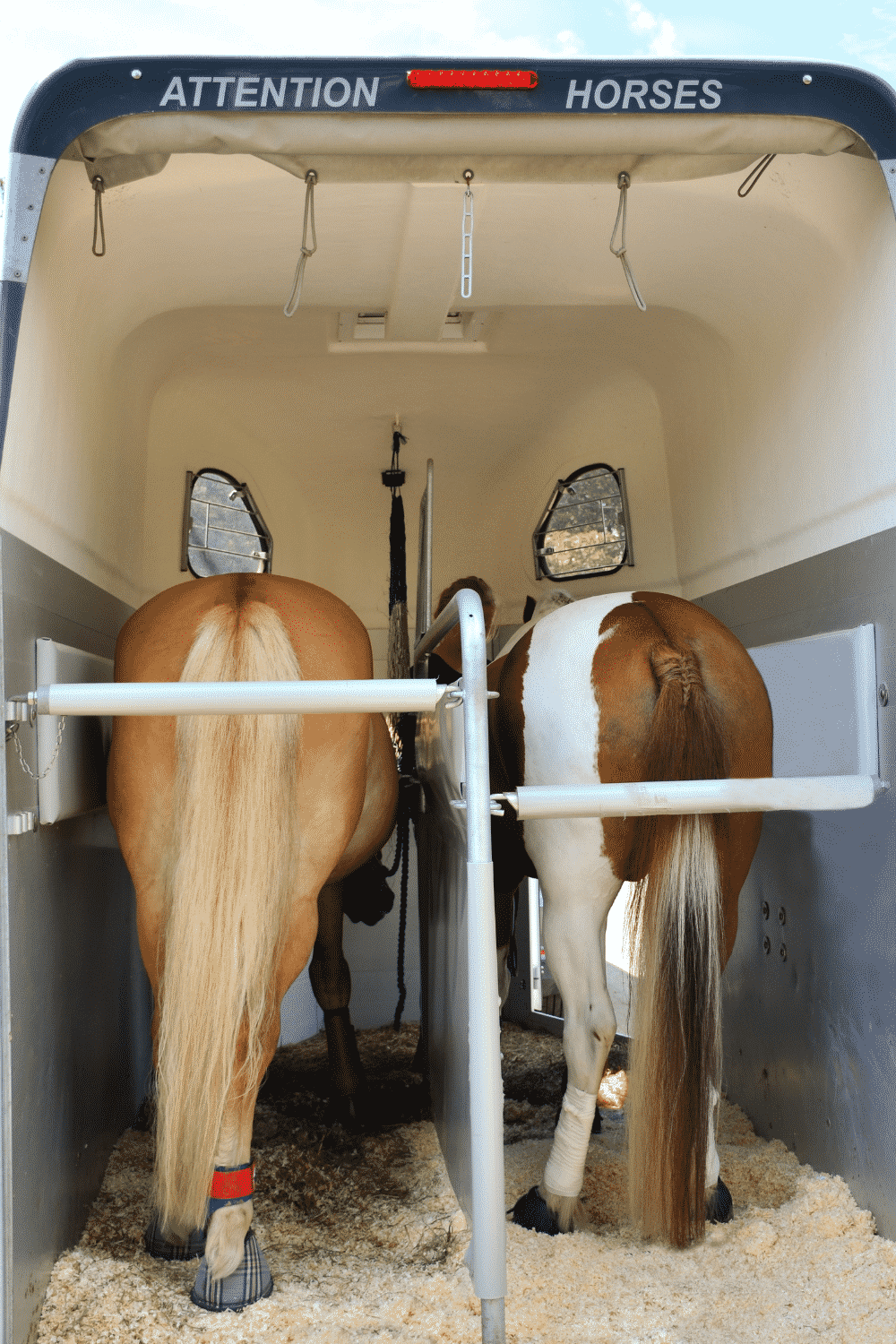
Reward your horse for all signs of calmness. If your horse starts to get restless, that’s okay but don’t reward that. Instead, just let him come out and then ask him to go back in after a few minutes.
If your horse doesn’t want to come out then reward that as well. Repeat this open-close process a few times as well.
Step 5 – Test ride
We’re going for a trailer ride! We’ll I’m not sure if it really counts if you only go down the street and back but it’s a big step either way.
For this step, you’re going to close your horse in completely and then you’re actually going to drive him somewhere. Around the block or down the street to someplace where you can easily turn around and come back is fine also.
You just want to show your horse that he is not going to die if he’s getting driven somewhere. It can be scary for a horse to be driven in a trailer for the first time so definitely don’t make it a long trip.
Just in case your horse freaks out and hurts himself accidentally you want to be aware as soon as possible and address it. If you’re driving for an hour, more damage could already be done and your horse will most definitely associate the trailer with a traumatic experience.
Step 6 – Test situations
Keep taking longer and long drives with the trailer. You can stop every once in a while just to check how your horse is doing and give him treats (not too many though – we don’t want him to get trailer sick!).
You also want to start loading him up in different situations. So try loading him somewhere where the ground isn’t even. Try loading him on different surfaces such as grass, stone, concrete or gravel.
These types of things may not seem that important until all of a sudden your horse just doesn’t like one thing about it and refuses to get in.
Eventually, up the ante and try in the rain, in a storm or with plenty of people around. As many different test scenarios as you can think of – simulate them all for loading. This will make your horse much more relaxed and show him that the trailer will always be safe no matter what’s going on around it.
Slow & steady always wins the race
I really can’t stress enough how important it is to keep your patience and take things slow!
I mean let’s say you hate eating asparagus. You’re not going to start love eating it after one day just because you’re told it’s healthy. It’s going to take a lot of very good experiences with it in surprisingly amazing recipes that might change your mind – if even then.
You’re trying to change your horse’s mind that he’s not going to hate being confined in a tiny little box that’s dark, loud and he can’t run anywhere if he gets anxious. You’re trying to make him realize that it’s safe and relaxing in there and there’s nothing to worry about.
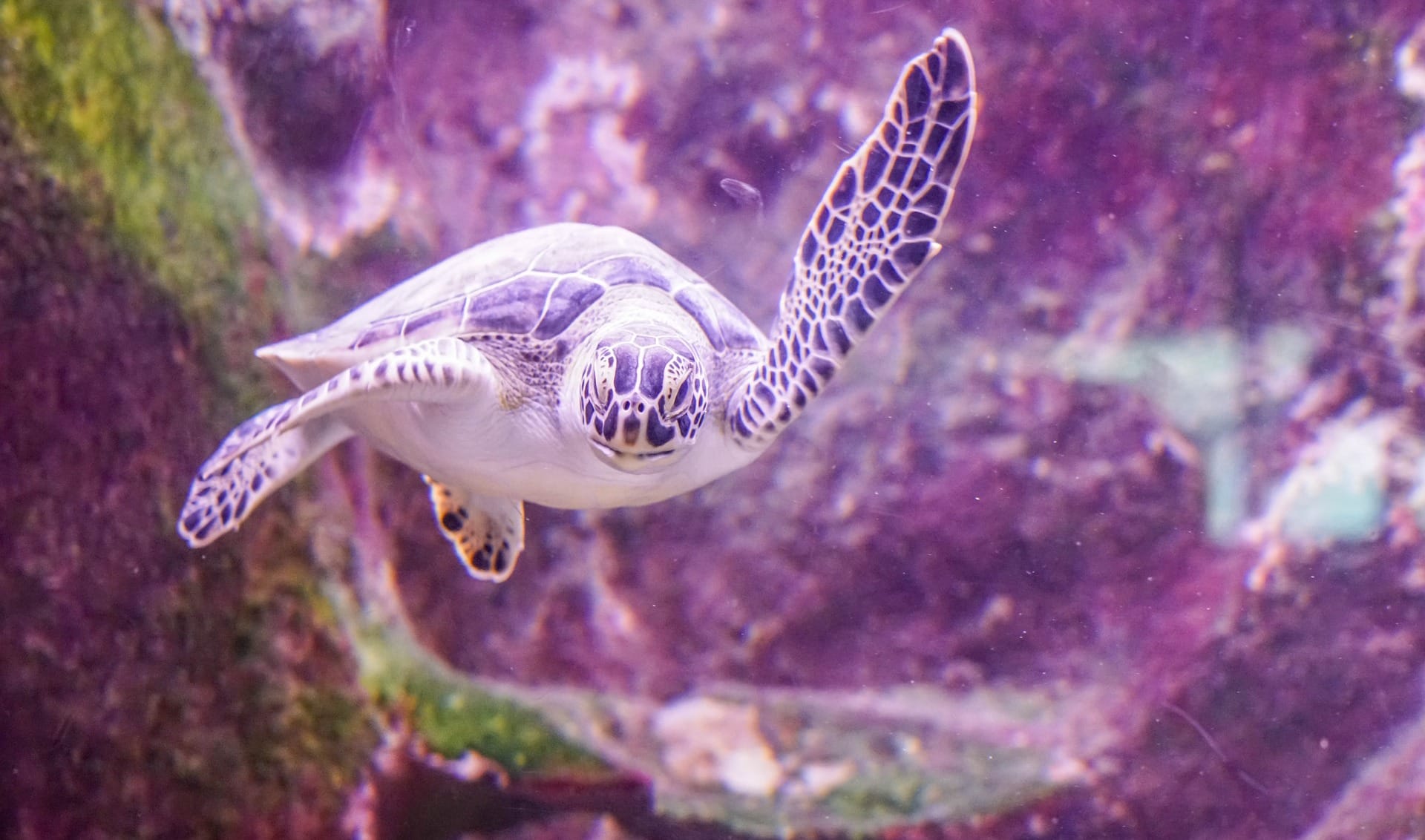
I would suggest even taking at least a day for each of the 6 steps above. Spend one day ground training, one day for introductions, etc.
Some steps might even take you longer like step 6 where you have to do a bunch of test situations. And that’s okay! I know you’re in a rush to just teach your horse how to get into the trailer because you need to take him places but if you want him to do it and do it right then you gotta put in the time.
Plus training experiences like this are great for building trust between you and your horse. Your horse will be much more trusting of you and more ready to follow your commands if you lead him confidently through exercises like this.
Another bonus of that is that it translates very well into the saddle!
Reward good behavior & discourage bad behavior
Through each of the steps, you should always be keeping in the back of your mind that you’re trying to reward good behaviour at each instance. As I mentioned for step 2 – even when he looks at the trailer he should be reward.
You want to build a positive impression of the trailer in your horse’s mind. I mean if you can get your horse to want to go on trailer rides, that would be ideal! Now wouldn’t that be nice?
You also need to be very strict. Don’t lose your temper but keep your calm resolve. There can be no give on your end. You can’t indulge any kind of bad behaviour.
What you’re asking your horse to do is the only option and there’s no other option. You’ve gotta keep pushing for it until your horse does it.
None of this: “okay we’ll go that way for just a minute and then maybe you’ll do what I want”. It never works! This just tells your horse that if he’s stubborn enough, he’ll always get his way. It also teaches him that you aren’t a good leader and you can be controlled.
Not a good thing for your horse to think when you’re riding him!
A complete list of things to avoid
Of course, when doing any type of training or work with your horse, safety is paramount. First and foremost for yourself. You can’t be there for your horse if you’re in the hospital! Second for your horse – because you love him and he’s pretty awesome!
You’re going to kill me for saying this again but don’t rush things! One step in the right directly is better than a kilometre in the wrong one. When you rush, you get frustrated.
And you can’t get frustrated with your horse because that’s not going to get anyone anywhere and might lead to an unsafe situation. It may be tempting at times but don’t scream at your horse or whip him in an attempt to get him to do what you want.
He’ll freak out even more and you’ll do the opposite of build trust between you two. Instead of building a positive relationship to the trailer, you’re building a negative relationship to yourself.
Also, frustration leads to things like using your own brute force without thinking. It’ll become like a tug-of-war, which I guarantee you’ll lose. Or trying to push your horse into the trailer, which again is a competition you’ll lose.
So instead, take a deep breath, re-focus and channel an aura of authority and calm. Channel your inner boss self – cool, calm and controlled. You’re in charge of this horse and he will do what you want in the end no matter what it takes. Plus you have all day!
So wuuuu-saaaaaaah and keep going.
Also, as I mentioned before, don’t get into the trailer with your horse. If your horse trips, gets spooked by something or is just anxious because he’s in there and tries to get out – you’ll be put in immediate danger. That’s a tight space and there’s no room for error.
Finally, don’t ever have your horse tied up before putting down the bum bar or put the bum bar up before you untie your horse. If your horse freaks out last minute and tries to get out, he could end up with a tug-of-war with the front of the trailer. That also won’t end well!
How to train a horse to load in a trailer – the 30 second recap
So basically what you’ve gotta do is through sheer will, establish a level of trust with your horse so that he follows your orders even though he might not want to. And you want him to form a positive relationship with the trailer using a series of positive reinforcement steps.
Just keep calm and trailer on! Eventually all of this will pay off and all of your friends will be asking you how in the name of stubborn horses you did it.
I really hope you found this post helpful. Please comment below if you have any questions or things you’d like to add or share.
Happy training 🙂

Hi Martina,
Another great post on horse training. Your post reminds me of Smallville if you have ever watched the movie since they ride horse a lot in there. I do not have a horse and never ride one before but I can feel how difficult it is to have a complete control over one. When you try to get your horse back out from the trailor, are you scared of it kicking you. I have heard some terrible stories on how it happened and it could take people’s lives in some cases?
Hi Kien!
Thank you for your positive feedback! I’m happy that you like my posts and yes I have seen it – pretty much any movie with horses that exists I’ve seen haha 🙂
Yes horses are tough to handle sometimes because they’re just so much bigger than we are so we have to try and connect with them as opposed to forcing them to just do what we want you know?
Definitely you have to be very careful whenever you’re behind a horse. The horse should always know where you are so that it doesn’t spook and kick out of fear. The best way is to have your hand on your horse’s rump or hold on to a piece of their tail at all times when you’re around their bums.
Also you should never stand directly behind them for an extended period of time because they obviously can’t see you and this can make them nervous. Also if they’re already stressed, then it might put them into a more anxious state. You can walk behind them with a hand on their rump but don’t just stand there.
Instead, and I probably should have been clearer about this in my post, you want to stand off to the side of the trailer that your horse is in. So don’t pull the horse’s tail while directly behind him, but stand off to the side so that there’s partial protection provided by the trailer. If you stand directly behind the horse and then ask him to move backwards, he’ll walk straight into you and that’s definitely not a good time haha.
But as long as you don’t make any sudden movements, show the horse where you are at all times with touch, and stand to the sides, you should be fine!
Cheers,
Martina
Thanks for explaining it so throughly! Now I know how to handle a horse in case I have this problem in the future. Just shared your post in twitter! And oh that picture “I see that apple in your hand!” is funny lol
Hey Kien,
No problem! Thanks so much for sharing my post 🙂 Haha yes horses tend to be like that – super silly but so adorable
Cheers,
Martina